What’s Really Behind Efforts to Reform Bail Reform? A Familiar Theme
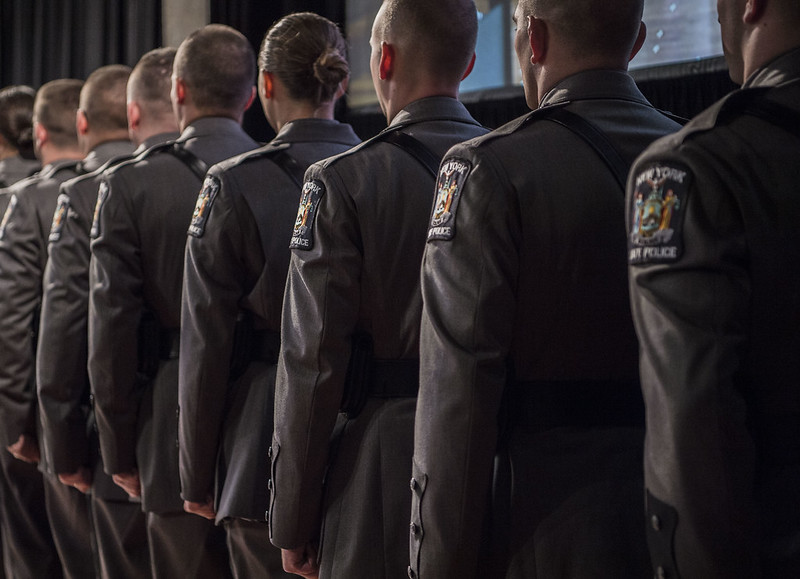
Law enforcement officials have pushed for bail reform rollbacks (photo: Governor's Office)
The hyperbolic vitriol about bail reform in New York should be viewed in context – it is but one example of the ways those with entrenched power in the criminal legal system rebel against even the slightest diminution of, or threat to, their authority.
Despite a growing movement for change, police officers, prosecutors, and judges cling to their absolute power to arrest, prosecute, and adjudicate with scant concern for due process, equal protection, or basic fairness.
Law enforcement representatives went on the offensive as soon as the reality set in that bail reform meant fewer people would be held at Rikers Island and other jails. NYPD Commissioner Dermot Shea penned an op-ed decrying the bail reforms and began lobbying in Albany for reforms of the reforms before the ink in the law books was barely dry. Shea’s Chief of Department, Terence Monahan, at precinct meetings with community members predicted an outbreak of violent crime.
District Attorneys also rallied to defend their threatened prerogatives. While prosecutors are supposed to enforce the law, it seems they spend much time figuring out ways to circumvent it, particularly as it relates to the recent bail, discovery, and speedy trial reforms. Last year, Bronx District Attorney internal documents revealed trainings in techniques to overcome speedy trial rules. More recently, a presentation at the New York State Prosecutors Training Institute included ways to avoid the impact of bail reform.
Perhaps the most telling example of prosecutorial unwillingness to cede even some control has been the outcry over having to provide the accused with speedy discovery of the evidence against them. It has been reported that the new obligation to comply with that fundamental constitutional right, a rule long recognized in virtually all other states, caused several prosecutors to resign.
Complaints about bail reform and new discovery obligations are hardly the only examples of opposition to meaningful reform of the criminal legal system. The ongoing fight over public access to police officer disciplinary records is another example of organized resistance to reform. New York Civil Rights Law §50-a, known accurately as the police secrecy law, restricts public access to a police officer’s disciplinary records even when there are serious and credible allegations of misconduct or violence. Efforts to fully repeal §50-a and put New York State in line with the rest of the country are vehemently denounced by the NYPD.
Prosecutors have supported this police campaign too, in an indirect yet effective manner. Even with §50-a on the books, prosecutors have the power to address part of the problem and to avoid relying on police officers with dubious credibility. Last year, Gothamist/WNYC reporter George Joseph reported that the city’s elected District Attorneys maintain secret databases that track police officer dishonesty. In some cases, prosecutors have created “do not call” as a witness lists of certain police officers. And yet these lists had not been provided to the accused, or their lawyers, who were arrested by these very same police officers.
Prosecutors have also organized resistance against other reforms that threaten their power. Consider the bipartisan legislative effort to create a Commission on Prosecutorial Conduct to review and investigate alleged prosecutorial misconduct. The bill’s stated purpose was to provide for a more transparent and just system. Prosecutors across the state denounced from the inception the very idea of outside oversight and claimed, without any hint of irony, that it violated their due process rights.
Nor is it only DAs and the NYPD who actively fight to reject reform of the criminal legal system. The courts, too, are determined to maintain the existing distribution of power, even if it means violating laws directed at limiting their actions. Two judges recently deliberately flouted the law by setting bail against the accused in circumstances explicitly prohibited by the new bail statute.
On a broader level, mimicking law enforcement, judges have taken to airing their opinions in public, calling bail reform a threat to public safety and predicting a spike in crime. Ironically, as judges rail against the new bail laws and demand greater discretion over when and on whom they can set bail, they ignore the point that it was in large part their irresponsible exercise of judicial discretion that led to the need for bail reform in the first place. Rather than rebel against reform it would be more appropriate for the judiciary to express collective contrition for having jailed so many people who lacked enough funds to pay their way home.
The hostility to any expansion of rights for the accused is manifest not just in New York’s lower courts, but all the way up to the Court of Appeals. Professor Vincent Bonventre of Albany Law School catalogued what seems like a concerted effort by the majority of judges to reduce the number of criminal cases heard by the Court. Even more troubling than the Court’s disinterest in hearing criminal appeals is the overwhelmingly pro-prosecution voting records of most of its judges. In 2017 and 2018, excluding cases where the Court was unanimous, Judges Jenny Rivera and Rowan Wilson voted in favor of the prosecution in less than 30% of the cases, while the rest of the members of the court ruled in the prosecution’s favor between 70% and 98% of the time. In fact, one judge sided with the prosecution in 96% of the cases in 2018 and 100% of the cases in 2017.
The Court’s unsympathetic approach to the rights of the accused is reflected in individual cases even more so than in the overall number of appeals denied. Luis Alvarez was convicted of brutal crimes committed when he was 19 years old. He was sentenced to 66 2/3 years to life – in other words, to die in prison. Years later, he challenged his sentence on the grounds that his appointed appellate lawyer failed to provide basic effective assistance of counsel by neglecting to challenge his sentence as unduly harsh and excessive.
The majority of the Court was not troubled by the death by incarceration sentence imposed on a teenager, or the obvious incompetence of appellate counsel, and denied Alvarez’s motion. Judge Rivera in her dissent detailed the many defects in the appellate brief, including that it contained several one-sentence paragraphs, misspellings, grammatical and typographical errors, and lacked citations to cases in support of legal arguments. The entire brief was 20 double-spaced pages, including the table of contents, even though the trial lasted three months and yielded a 4,000-page transcript. In contrast, the prosecutors’ brief was over 175 pages.
The majority of the Court minimized the many faults Judge Rivera highlighted (though noting that the brief was “somewhat terse, could have been better drafted, and is not a model to be emulated”), and ruled that Alvarez received effective assistance of counsel.
Judge Wilson in his dissent, besides noting the “atrocious” quality of the brief, wrote about the man Alvarez had become and why it is wrong to prejudge the entire future of a teenager. Judge Wilson noted Alvarez’s positive disciplinary history in prison, his record of programmatic achievements, and his current medical condition – Alvarez’s cancer went undiagnosed until it metastasized, and he is now a paraplegic. Judge Wilson closed his dissent by asking how anyone would feel about the quality of appellate counsel if Alvarez was their son. You don’t have to be a legal scholar to know the answer to that question.
The outrage over bail reform reveals much more than outrage over bail reform. It exposes the entrenched nature of the criminal legal system as ferociously dedicated to maintaining absolute power and the status quo. While the criminal legal system is not unique among governmental entities intent on maintaining a brutal grip on power, the concerted effort to eviscerate bail reform provides clear evidence that all efforts to impose even a modicum of fairness and decency on the criminal legal system will face near pathological resistance.
***
Steven Zeidman is a professor of law at CUNY School of Law. On Twitter @SteveZeidman.
***
Have an op-ed idea or submission for Gotham Gazette? Email This email address is being protected from spambots. You need JavaScript enabled to view it.
A State Budget Necessity: Start-Up Funds for New Campaign Finance Program
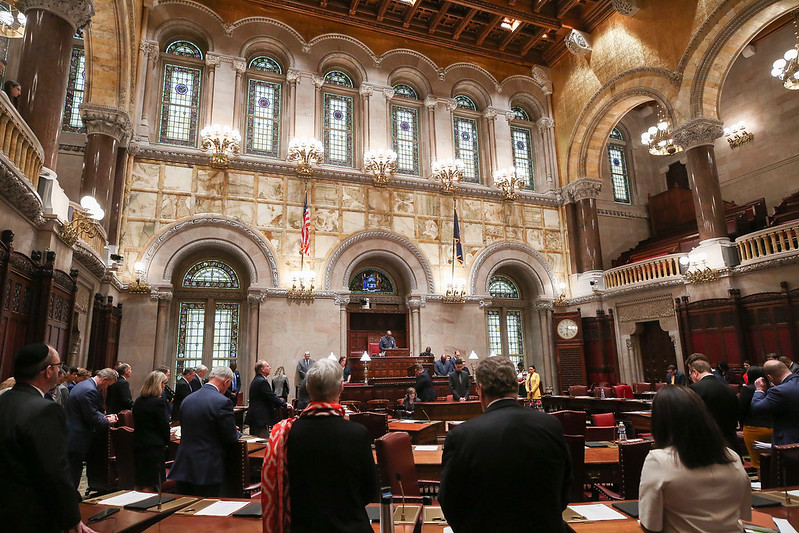
State Legislators have an important decision to make (photo: NY Senate)
In New York State, money doesn’t only talk, it decides who does the talking, who makes the laws, whose voices matter, and who gets left out. After years of grassroots activism, New York State is a big step closer to shifting the balance of power in Albany through a new public campaign financing program, moving away from big-monied interests and toward regular New Yorkers.
A new state campaign finance system with lower contribution limits and public matching of small donations became law in December, designed by a commission appointed by Governor Cuomo and legislative leaders after years of Democratic officials like the governor talking about support for reform. But Cuomo has omitted necessary implementation funds from his proposed budget for next fiscal year, which begins April 1. Without sufficient resources to scale up, the new system of public campaign financing can’t have the impact we need for change.
The ideal reform would amplify the voices of black and other historically marginalized people by using public matching funds in electoral campaigns throughout the state. Yet Governor Cuomo’s failure to fund implementation, coupled with his support of new ballot access restrictions the commission created to hinder smaller political parties, casts serious doubt on his claims of wanting a better democracy.
When Senate Majority Leader Andrea Stewart-Cousins and Assembly Speaker Carl Heastie release their majorities’ own one-house budget proposals this month, they must include start-up funds for public financing and then urge the governor to agree to such funding in their final adopted budget. The three leaders must assure the millions of New Yorkers who have been shut out for too long that this transformative reform is here to stay.
Public financing of elections is a matter of racial justice. Black, poor, and working-class New Yorkers cannot truly build political power and combat racism and oppression if big donors — who are overwhelmingly wealthy and white — continue to hold outsized influence. In 2018, just 100 big donors gave more to New York state candidates than all estimated 137,000 small donors combined.
Regular New Yorkers would have greater influence to counter powerful special interests with small donor public financing, which matches low private donations with public funds for candidates who choose to participate. In New York City, legislative candidates who opted into the city’s matching funds program relied more on the residents of their districts for support than candidates who did not use public financing.
The new state program would increase the campaign finance influence of constituents even more than in the city’s program. For legislative candidates, only small donations from within the district they are running to represent would be matched. That may seem like a limited pool of potential funds for a candidate, but the level of match is sizeable enough to enable someone to raise competitive sums. Even the smallest donation from a constituent will be important, as a sliding scale gives the highest match of public funds for the lowest dollars.
And private fundraising requirements to participate in the program are lower for candidates running in low-income districts, making the possibility of electing candidates of constituents’ choice even greater. Experts say these features are innovative and could be models for other parts of the country looking for alternatives to the undue influence of big donors in their elections.
We will keep fighting to improve the new program. With the proper funding and support it will be profoundly better than the old way, which perpetuated racial injustice and outsized political power for the wealthy by letting millions of dollars drown out millions of people.
There’s no time to lose to start building the program, which is set to launch in November 2022 for candidates running in the 2024 legislative and 2026 statewide elections. The State Board of Elections has requested the modest outlay of $2.7 million for this year to hire staff and build the technology needed to provide a solid foundation for the program.
The governor and legislative leaders must commit to deliver the public financing program that they promised just a few months ago. If we ever want to have real democracy in New York, political voice and representation must finally become open and equally accessible to black and brown communities in our state.
***
Monifa Bandele is Senior Vice President for MomsRising.org and a member of the Leadership Team of the Movement for Black Lives Policy Table. On Twitter @monifabandele.
***
Have an op-ed idea or submission for Gotham Gazette? Email This email address is being protected from spambots. You need JavaScript enabled to view it.
Bail and Other Misguided Laws Started with Loss of Republican Senate
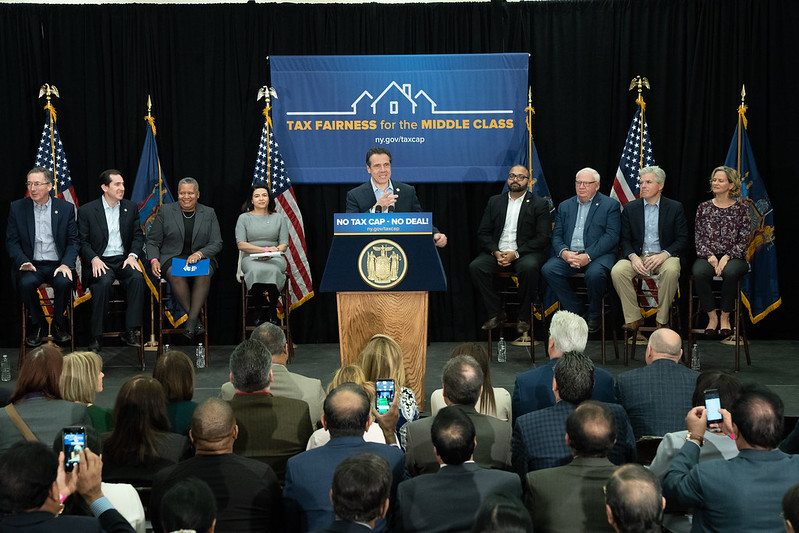
Gov. Cuomo and Long Island Democrats (photo: Governor's Office)
Long Island residents are finding out the hard way, once again, why it was so important to keep a balance of power in New York State via a Republican-controlled Senate and Democrat-controlled Assembly.
When Democrats took over the Senate after the 2008 election, it led to the horrendous MTA tax, which forced schools, nonprofits, and businesses throughout Long Island to pay a huge payroll tax to foot the bill for the city transit system. The bill was put over the top by two Democratic senators from Long Island. The public rebelled and the Senate was put back into the hands of the Republicans.
But in 2018, the tide shifted back to Democratic control in the Senate and throughout state government. “Don’t worry,” we were told, the Long Island bloc of Democrats will be moderate and stop the extremists from implementing dangerous policy. How did that work out?
Laws were passed giving driver's licenses and taxpayer-subsidized college scholarships to undocumented immigrants. Abortion was allowed up to the time of birth. Nine days of early voting, costing millions of dollars, was enacted when just a few days would have sufficed. Unrealistic limits on energy production will cause our electric bills to soar. And, of course, the new bail reforms are undermining public safety and order.
Our Long Island delegation is made up of well-intentioned, hard-working, and dedicated legislators. They will claim that they voted against some of these measures, including the driver’s license law, and can still be counted on to be an effective voting bloc. But it’s not their individual votes on these matters that are most important.
Rather, it’s the singular vote they take at the first legislative session of the year that leads to all these negative outcomes. That is, the vote to put in place a liberal Democrat at the head of the Senate, who then appoints New York City-centric “progressives” to be in charge of just about every committee and push the agenda. Consequently, uber-left legislation that in the past would have been stopped in these committees and never seen a Senate vote are now getting out to the floor.
Numerous local senators are now scrambling to undo the damage done by bail reform, but this misguided law would never have passed had Long Island Republicans still been in charge.
As impressive as these newly-minted senators are, the bottom line is they will vote to continue to have the New York City-centric liberals running the committees and dictating much of the chamber’s agenda. And that is not good for Long Island.
***
Steve Levy is President of Common Sense Strategies, a political consulting firm. He served as Suffolk County Executive, as State Assembly member, and host of "The Steve Levy Radio Show." On Twitter @SteveLevyNY.
***
Have an op-ed idea or submission for Gotham Gazette? Email This email address is being protected from spambots. You need JavaScript enabled to view it.
Do Homeless Lives Matter to the De Blasio Administration and City Council?
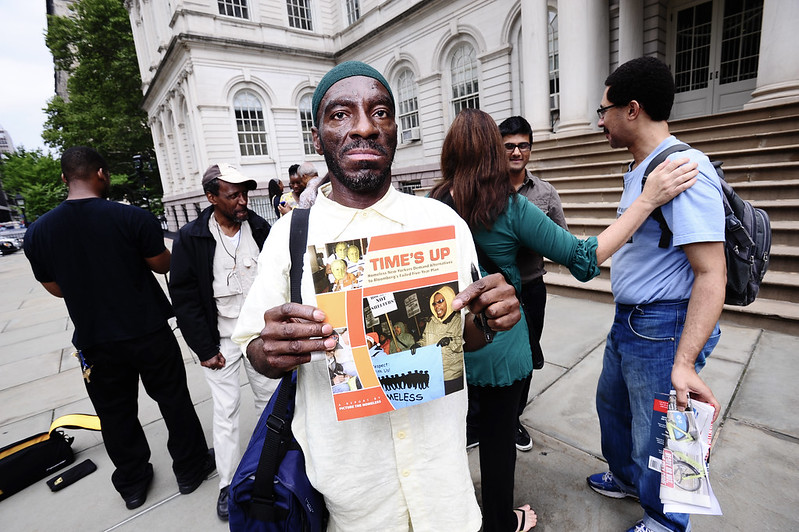
(photo: William Alatriste/City Council)
Imagine the reaction if the number of deaths within a particular neighborhood or among a certain ethnic, racial, or religious group had gone up by 40% in one year! There would be demonstrations on the steps of City Hall and the Mayor would be forced to respond.
Unfortunately, that is what has happened among the city's homeless population. Between July 2018 and June of 2019, 404 people considered homeless in New York City died, according to a recently-released city report. That is a 40% increase over the prior year and the largest year-over-year increase in a decade.
Many of these deaths did not occur within shelters. Homeless people died in hospitals, on subway cars, in abandoned buildings, and in vacant lots. The majority were middle-age men. Drug addiction, alcoholism, and heart disease were major contributors in many of the cases.
However, 15 homeless people died by suicide, which was more than double the amount in the previous year, and three of those individuals took their own lives inside a shelter. There were also 10 homicides, three more than the prior year (and although none took place in a shelter during the reporting period, at least two people were killed inside a shelter between July and December 2019).
In addition, 17 infants died in the system compared to 10 the prior year, a shocking number. Many of these cases are still under investigation. In addition, women also died more frequently than the prior year, to 91 deaths, up from 59, another incredible increase.
You would think such shocking statistics would sound an alarm at City Hall, but the administration‘s reaction to this has been underwhelming at best -- that basically it’s not their fault because these deaths and underlying conditions are results of “chronic health conditions due to decades of risk factors,” as city Social Services Commissioner Steve Banks told Gothamist.
Incredibly, administration officials seem to brag that when it comes to drug-overdose deaths, they have been able to keep the numbers steady, but at a high rate of 103 accidental drug overdose deaths.
Dr. Mitchell Katz, the CEO of the city’s public hospital system, told Gothamist that the overall increase in deaths among homeless people is driven by an aging homeless population and easy access to cheap drugs. In fact, the majority of those who died last fiscal year were middle-age men and there are 1,400 seniors in the shelter system.
Why is it then that seniors and middle-age men and women are not being prioritized into the supportive housing system? A middle-age man and woman in a homeless shelter system is equivalent to a much older person living a stably-housed life. The city must urgently move to get middle-age people and seniors who are living on the street and in the shelters into supportive housing as quickly as possible.
As someone who has run two supportive housing programs I know the advantages of these programs, which give a homeless person their own apartment and a social worker to speak with on a regular basis, among other services. Unfortunately, the placement rate into supportive housing is at a 14-year low, according to Coalition for the Homeless. Be aware that an increase in affordable housing coming online is not going to help this group. You need housing that is structured for supportive services and for a population that has no income.
We can no longer allow homeless people who are living on the streets and in the subway system to vegetate and sleep in filthy conditions, many of those who do clearly have serious mental and physical health issues. The current standard of when someone can be committed to a psychiatric hospital is that the person has to be a threat to themselves or others. However this has been interpreted too strictly.
A commonsense approach has been proposed by Loree Sutton, a former Army brigadier general and psychiatrist who was the city’s veterans services commissioner until resigning and announcing her candidacy for mayor in 2021. Doctor Sutton has suggested that the civil commitment law be amended so that seriously mentally ill people can access inpatient services before exhibiting an immediate danger to themselves or others. Of course we also must stop the elimination of psychiatric beds and reverse course to substantially increase the number of those beds available in the city and state.
Health services must be improved within the shelters and we need to quickly increase the number of drop-in centers that will allow people to get off the street quickly and receive food, clothing, showers, medical care, and access to a social worker. A nurse at a drop-in can quickly diagnose an urgent medical problem and call for an ambulance. We now have only two of these centers in Manhattan.
The very shocking statistics of fatalities among the city’s homeless population must be investigated and the subject of a City Council oversight hearing. The Council cannot allow the administration to sweep this under the rug and cast off blame. The large increase to an already unacceptable problem must be paid the attention it deserves.
***
Robert Mascali is a former Deputy Commissioner at the Department of Homeless Services and a former Vice President for Supportive Housing at Women in Need.
***
Have an op-ed idea or submission for Gotham Gazette? Email This email address is being protected from spambots. You need JavaScript enabled to view it.
A Cruel Surrogacy Proposal That New York Must Reject
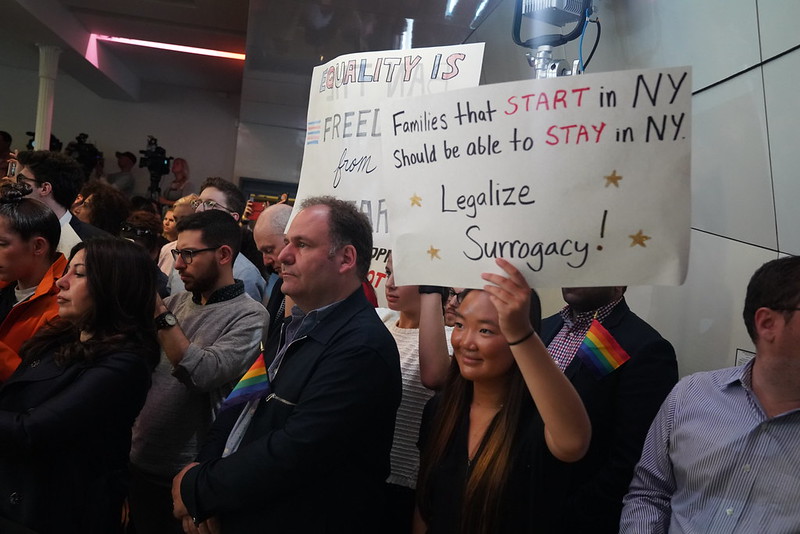
There are competing proposals to legalize surrogacy in NY (photo: Governor's Office)
Imagine having a baby but then being told you have to wait eight days before securing custody of your child. It’s bizarre and cruel, yet it’s an idea that’s actually being floated in Albany right now as a “compromise” to finally end New York State’s outdated ban on gestational surrogacy.
As a three-time cancer survivor in my thirties who went through three rounds of fertility preservation before treatment, this is heartbreaking. I choose to live in New York for many reasons, one of them is the progressiveness of our laws. We are leaders, but not on surrogacy. Now, it’s essential we catch up, and there’s nothing progressive about a bill separating newborn babies from their biological parents just days after birth.
During my cancer recovery, I was shocked to learn New York is one of only three states banning surrogacy. This is an issue that hits home for me and the women I work with who have also survived cancer. For many cancer patients, infertility is an enormously emotional and physical side effect of life saving treatment. This can mean a significant decrease in number and quality of eggs, as well as the inability to carry a child to term. In many cases, the only possibility for having a biological child is through a partnership with a woman acting as surrogate.
Last year, Governor Cuomo, signed FAFTA (the Fair Access to Fertility Treatment Act) into law. Part of this mandate (that went into effect January 1, 2020) requires private insurance companies to provide fertility preservation medical treatments for people facing iatrogenic infertility, that is, infertility caused by a medical intervention, such as radiation, medication, or surgery. The next obvious step is to figure out a solution that helps these women become mothers after their cancer chapter has closed.
Currently, New Yorkers in this situation are forced to go out of state to find a surrogate. A bill that would end that ban, the Child-Parent Security Act, has the strong support of Governor Cuomo and passed the state Senate last year before dying in the Assembly. It is under serious consideration again this year, with the governor prioritizing it in his budget proposal.
Now a new bill is being sold as a “compromise” that while technically legalizing surrogacy would also effectively eliminate its practice in New York. This means an exacerbating ‘well we tried’ response from people who don’t take New Yorkers’ needs seriously.
The so-called compromise bill (S7717), sponsored by Senator Liz Krueger and by Assemblymembers Didi Barrett and Danny O’Donnell, would establish that after a child is born via surrogacy, the surrogate (who has no genetic relationship to the child) and the intended parents (who in most cases do have a genetic relationship to the child) would share parenting responsibilities for up to eight days. The surrogate could take the child home if she chose to. And if she petitioned the court within those eight days, she would automatically become the legal parent of the child with no recourse for the intended parents. In order for the intended parents to become legal parents, they would need to submit to medical evaluations, home studies, and background checks. Last I checked, these are not requirements for those with the ability to become mothers the traditional way.
Think about how cruel this proposal is for women struggling with infertility, including cancer patients. Imagine having to undergo treatment, doing everything possible to preserve fertility options, recovering from cancer, creating an embryo through IVF, and ultimately partnering with a woman who will carry your child to birth as a surrogate. And then still having to worry every day of the pregnancy that at the end of the process, the woman who is serving as a surrogate will change her mind and keep your child. It’s frightening, cruel, and just outright wrong.
It also reflects a lack of understanding about what surrogates want. Under professional practices in the United States, every surrogate already has their own biological children and have undergone careful medical and psychological screening. These women know exactly what they’re engaging in – they’re not pursuing surrogacy to have another child, but to help a family that cannot have children on their own.
Conversely, the Child-Parent Security Act would go far in helping those struggling with infertility in New York build a family. This is where New York can establish itself as a leader once again, now as it relates to surrogacy. In addition to legalizing compensated gestational surrogacy agreements, the legislation would create peace of mind for intended parents and establish the strongest protections in the nation for women serving as surrogates. Critically, the legislation would create a Surrogates’ Bill of Rights in New York, ensuring that women serving as surrogates have the right to make all medical decisions regarding their health and the pregnancy, the right to independent legal counsel, the right to comprehensive health insurance, and the right to access counseling.
Given the additional pain and trauma Senator Krueger’s proposal would put cancer patients seeking to become parents through surrogacy through, I hope she will consider withdrawing it and choosing instead to support the Child-Parent Security Act. New York must legalize surrogacy agreements and I applaud Senator Krueger for recognizing that need. But it is critical that we do so in a way that does not create additional trauma on intended parents – who have already gone through so much – and that protects women who serve as surrogates in New York.
***
Amanda Rice is the founder and CEO of the Chick Mission, a non-profit focused on critical issues unique to young, female cancer patients – including fertility challenges that may follow after surgery, chemotherapy, radiation, and drug treatment. On Twitter @thechickmission.
***
Have an op-ed idea or submission for Gotham Gazette? Email This email address is being protected from spambots. You need JavaScript enabled to view it.
New York Has Already Moved Beyond Indian Point Nuclear Power; Here’s Where We’re Headed

(photo: Kevin P. Coughlin/Office of Governor Andrew M. Cuomo)
Despite the last-minute denials in an op-ed column recently published in these pages, there’s actually good news regarding replacement energy for Indian Point’s 2,060 megawatts once it goes offline in April. The New York Independent System Operator — which coordinates the distribution of our electricity supply — says that New York will have enough replacement power to supplant the aging, problematic nuclear plant’s output once it closes, and it can be done with combinations of clean energy sources, transmission improvements, and energy efficiency.
Furthermore, in the last three years alone, enough clean energy and efficiency has been installed to replace one of the two Indian Point reactors. We’ve already made considerable progress toward replacing Indian Point with demand reduction, additional transmission, and new renewables, and we are continually making more at an ever faster pace.
Therefore, there will be no problem keeping the lights on when Indian Point closes while New York’s energy grid continues to reduce its reliance on fossil fuels. Moreover, the energy doomsayers forget that Indian Point is one of the most dangerous reactors in the country, surrounded by the largest population. We simply cannot take further safety risks and must close these reactors.
Increasing clean energy initiatives continue to be the foundation of New York’s efforts to combat climate change. In 2019, Governor Cuomo announced the procurement of 1,750 MW of offshore wind to add to the energy mix, while NYISO also approved 1,250 MW of transmission improvements that will allow wind and other renewables to get from upstate to downstate more easily by relieving two major bottlenecks. Additionally, battery storage can increasingly replace power plants that operate only during peak usage.
In Albany, Riverkeeper joined a full-court press by environmental and environmental justice groups to convince lawmakers to pass landmark legislation to combat climate change. The Climate Leadership and Community Protection Act, signed into law by Governor Cuomo, establishes aggressive mandates to ensure a 40 percent reduction in greenhouse gas emissions by 2030 and an 85 percent reduction — with 100 percent carbon neutrality — by 2050.
It also codifies Governor Cuomo’s goals to achieve 70 percent low-carbon electricity by 2030 and 100 percent low-carbon electricity by 2040. The 2050 mandate stands as the most comprehensive and aggressive climate bill ever enacted at the state level. The bottom line is that the CLCPA will ensure that gas plants are rapidly phased out as more clean energy is generated.
The CLCPA also begins to address fairness and equity for environmental justice communities — those at the greatest risk from potential climate change-related impacts. While the law could have gone further to ensure economic justice for those front-line communities, it does require a proportion of state energy and climate investments to be made in these communities and it attaches fair labor standards — including prevailing wage standards — to all green projects receiving state funding.
Indian Point, on the other hand, is neither safe, clean, nor green. The plants are ranked the worst in the nation on earthquake risk, they had troubling problems with aging of the bolts that hold the reactors together, and there is no viable evacuation plan in case of an accident. Indian Point’s antiquated once-through water cooling system kills over one billion fish and fish larvae each year. The system withdraws 2.42 billion gallons per day from the Hudson and heats it up to a deadly temperature before discharging. Fish are killed when they are impinged on filter screens, entrained through the cooling system, and scalded by hot water. Evidence indicates that over 40 years, such slaughter and habitat degradation have contributed to the decline of numerous important fish species in the river. Also, the pools at the plant that house spent nuclear fuel have been leaking toxic, radioactive water into the ground since the 1990s, contaminating the local soil and the Hudson River.
Now, with the nation’s most aggressive climate legislation and the shutdown of Indian Point, New York’s energy landscape is about to be transformed for the better. Going forward, energy efficiency and renewable power will more than make up for the loss of generating capacity at Indian Point. Not only are no new gas plants needed, existing plants will rapidly come under pressure to close as the green transformation of New York’s power grid ramps up.
***
Richard Webster is the Legal Director for Riverkeeper. A graduate of Columbia University Law School, he was formerly a staff attorney in the Environmental Enforcement Project at Public Justice. On Twitter @EnviroWeb & @riverkeeper.
***
Have an op-ed idea or submission for Gotham Gazette? Email This email address is being protected from spambots. You need JavaScript enabled to view it.
Letter to the Editor: Cuomo’s Climate Plan Isn’t Serious, But Nuclear Still Isn’t the Answer

Indian Point power plant (photo: Governor's Office)
In an opinion piece by Leonard Rodberg and Herschel Specter, “Is Governor Cuomo Serious About Climate Change? Indian Point Decision Says No,” published March 2, the authors argue that the climate plan for New York is not serious because it cannot accomplish the desired reduction in greenhouse gas emissions. However, they claim, it is easy to make the plan serious by cancelling the planned closure of two nuclear power plants. Their arguments are the same as in their prior pro-nuclear opinion piece from last year, namely that enough renewable energy and the corresponding infrastructure is not being built and cannot be built.
In my letter to the editor that appeared in response to that piece I replied that nuclear is no solution because the waste has to be kept and managed in perpetuity and can do enormous damage if some of it escapes. The effort needed to maintain it should instead be going into renewables. This is still my opinion.
But I also agree with the statement that the Cuomo plan is not serious. In this respect the plan is in keeping with national policy consistently followed over the last 35 years. It is a policy clearly declared by the U.S. Senate in the period leading up to the Kyoto agreement in 1997. Kyoto was then not ratified; this was enough to make it irrelevant. Since then the rhetoric changed a few times but the essence did not.
Big business in the United States has been investing in fossil fuels ever since. It intends to reap the profits of these investments. It is also aware that the climate crisis, as it progresses, hits the competitors of the U.S. harder. So there is a practical consensus in this matter within big business, even if in other things there is not.
Of course in the end, and nobody knows where the tipping point is, all human life becomes impossible. But the consensus is that this tipping point is likely to be far away and the present policy is worth the risk. As a result, a plan to build up New York City’s flood defenses for $119 billion or to build a sea wall in the North Sea between Scotland and Norway for $500 billion is seriously discussed, while the Green New Deal is rejected out of hand as utopian and impossible.
Things being as they are, could Cuomo, pressed by New York public opinion, go against the grain and do more? I think he certainly could. He could forbid or at least heavily tax new fossil fuel installations; he could speed up energy-saving measures; he could incentivize solar panels; he could speed up building the planned large wind farm. Last but not least, he could make it perfectly clear that the federal government must be involved, and a national Green New Deal, as it has been proposed, is urgently needed.
Sincerely,
Adam Koranyi, retired professor at CUNY Lehman College
***
Have an op-ed idea or submission for Gotham Gazette? Email This email address is being protected from spambots. You need JavaScript enabled to view it.
Coronavirus In Our City: New York Must Mobilize Resources and Avoid Scapegoating

Coronavirus briefing by Mayor de Blasio & others (photo: Ed Reed/Mayor's Office)
With the first confirmed cases of the Wuhan coronavirus, COVID-19, in New York City, our communities are on high alert. We fear that New York’s Chinese community, where I live and work, is especially at risk. That is why we are prepared to leverage our culturally competent care model to bridge any gaps that may render our communities vulnerable.
I lead a non-profit health organization, SOMOS, that oversees the health delivery for nearly one million New Yorkers, mainly lower-income, and almost all immigrants like me. Our network includes over 300,000 Chinese patients in my neighborhood of Sunset Park, as well as neighborhoods in Lower Manhattan and Queens. We must prepare to meet the challenges of cases of infection now in New York.
In our backyard, over 100 possible cases are being examined on Long Island – mere miles from New York City. Rightfully, there is a reason for public concern, and we are already seeing the capability of this coronavirus to disrupt various aspects of our lives. The need to adopt best practices and to contain the virus - and mass hysteria - are critical.
In the last couple of days, the virus has pummeled the global financial market, caused countries to issue emergency declarations, and forced the cancellation of thousands of social and cultural gatherings. The virus has infected nearly 90,000 people, and over 3,000 deaths in at least 53 countries, including the first mortality in the United States, where over 75 known cases are reported.
Now is the time for government leaders to work closely with the community and family doctors who are the first line of defense in a public health crisis that hits vulnerable communities – especially those in immigrant communities who are typically isolated by culture, language, poverty, and customs.
Moreover, we must continue not to let fear rule our actions or scapegoat the Chinese and other Asian-American communities. With more panic and increased hysteria, there is a greater temptation to blame perceived outsiders. But when people play off stereotypes, it distracts from the actual risks and feeds into misinformation around the virus.
Let’s instead focus on the facts. Our community members must also understand that those who contract the coronavirus can recover unless they have other underlying health issues.
New Yorkers should follow precautions as they would during cold and flu season every year. But if you are feeling well and symptom-free, continue with your daily life per usual – go to work, run your errands, and spend time with your loved ones.
Likewise, good hygiene is imperative. Washing hands frequently and covering your mouth – with a tissue or your sleeve instead of your hand – when sneezing or coughing. Also, it is crucial to keep the home and surroundings clean and disinfected and to visit a local pharmacy or health care provider to get the flu shot for individuals who haven’t done so this year.
We must continue working together to educate and inform New Yorkers on symptoms to watch out for, ways to protect themselves and their loved ones, and what to do if there is a suspected case of infection.
Top symptoms include coughing, fever, and trouble breathing. Individuals experiencing these symptoms that have recently traveled to outbreak zones or had close contact with someone who recently visited outbreak zones should contact their healthcare provider immediately. Calling ahead and notifying providers of travel plans or symptoms after traveling are recommended best practices. Then, avoiding contact with others until medical professionals instruct otherwise.
Healthcare providers in Chinese communities and throughout New York City are ready to meet the challenges of the outbreak, but we cannot do it alone. We need cooperation from all our federal, state, and local partners to coordinate with health officials, healthcare networks, and community-based organizations to ensure we are doing everything to prevent the spread of the virus effectively.
If we all prepare, educate, and remain calm and vigilant to the signs and symptoms, we can avoid panic – and, most of all, ensure that New Yorkers stay healthy.
***
Dr. Henry Chen, MD, is President of SOMOS, a non-profit, physician-led network of over 2,500 health care providers serving over 700,000 Medicaid beneficiaries in New York City. On Twitter @SOMOScare.
***
Have an op-ed idea or submission for Gotham Gazette? Email This email address is being protected from spambots. You need JavaScript enabled to view it.
Coronavirus, Criminal Justice and Civil Liberties
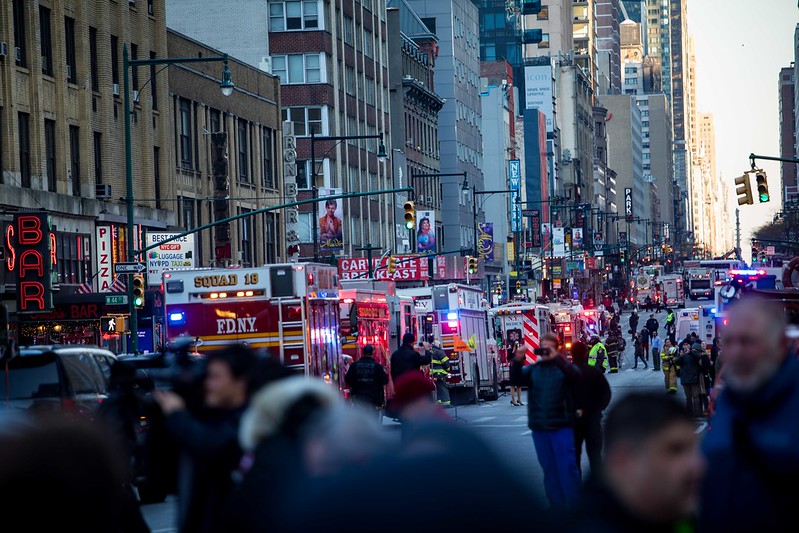
(photo: Benjamin Kanter/Mayoral Photo Office)
While New York’s public health system is doing its best to combat the coronavirus, we need far more assurance from elected officials, especially those involved in our criminal justice system, that they are ready to protect our civil liberties in this emergency. As a civil rights attorney, I know that we must meet this moment with a response that honors public safety, protection from discrimination and price-gouging, civil liberties, and regard for those most marginalized, including people in our jails. We cannot sacrifice our basic values in the name of emergency.
Public health is a matter of public safety, and that is why we must give our health officials the resources they need to fight the coronavirus. But too often in these emergencies, marginalized communities are left behind, whether they are people in NYCHA public housing, homeless shelters, or jails and prisons. This health crisis is also a justice issue.
We must protect vulnerable populations in jail and prison, which are dangerous breeding grounds for a disease like the coronavirus. People are held in close quarters in unsanitary conditions, with medical facilities that are strained under normal circumstances. There is reason to believe a local federal facility is already experiencing issues.
We should explore “medical furloughs” for elderly people being held in our jails and prisons to be removed during the pendency of the outbreak if they have safe places to live in the community. Elderly people in prison with active clemency applications should have those expedited and approved when appropriate. Likewise, we should impose a moratorium on jailing technical parole violators. These individuals, who have broken parole rules (rather than the law), pose virtually no public safety risk, and now is not a good time to crowd jails with them. Consider that Iran has released more than 54,000 people from its prisons to slow the spread of the disease.
We must defend civil liberties, which are always tested in times of crisis. On Monday night, Governor Cuomo pushed through legislation that would confer upon him extraordinary powers to suspend laws and enact new measures to respond to not only this emergency, but events as vague as “storms.” The New York Civil Liberties Union and progressive leaders like State Senator Gustavo Rivera correctly criticized the reckless manner in which this sweeping law was passed. And within our city, should the spread of the virus worsen, we must be very careful about not implementing restrictions on movement that will actually make it harder to fight the disease - such as shutting down forms of transit used by our healthcare workers. On this we can learn from the South Koreans in Daegu, who have promoted transparency and made few impositions on liberty even under a much more severe outbreak.
We must combat price-gouging, especially as hand sanitizer and other products become harder to come by. There is already a law against price-gouging during an emergency, and Senator Brad Hoylman has introduced good legislation that would strengthen it. The law empowers the New York Attorney General to fine culprits, but that will only deter companies if they think they’ll be held accountable. That’s why the city’s District Attorneys and other relevant agencies such as the New York City Department of Consumer Affairs should publicize easy ways to report price-gouging.
We must be vigilant against discrimination. We should follow the lead of Assemblymember Yuh-line Niou and denounce media depictions that promote anti-Asian sentiment. Likewise, we must reject the Trump administration’s castigation of Iranians, Mexicans, and other groups this administration will “other” during the outbreak. If that sounds obvious, remember our city is less than a decade removed from succumbing to right-wing Islamophobia during the “Ground Zero Mosque” controversy, when two-thirds of New Yorkers opposed building a Muslim community center. Should tensions rise, we must be unequivocal: we will not allow discrimination to flourish. This is a global crisis, we are all in this together.
This is a serious moment for our city, and some of our leaders are nowhere to be found. Implementing the right health response will require steady leadership, robust coordination, and aggressive outreach from our government. By honoring values like civil liberty, thinking creatively, and protecting marginalized communities rather than succumbing to fear, New York City can show national leadership in its response, and prove itself ready for more 21st century challenges ahead.
***
Janos Marton is an attorney and a 2021 candidate for Manhattan District Attorney. On Twitter @janosmarton.
***
Have an op-ed idea or submission for Gotham Gazette? Email This email address is being protected from spambots. You need JavaScript enabled to view it.
Fare Evasion Shouldn’t Be a Crime; Neither Should Putting Your Feet Up on the Subway
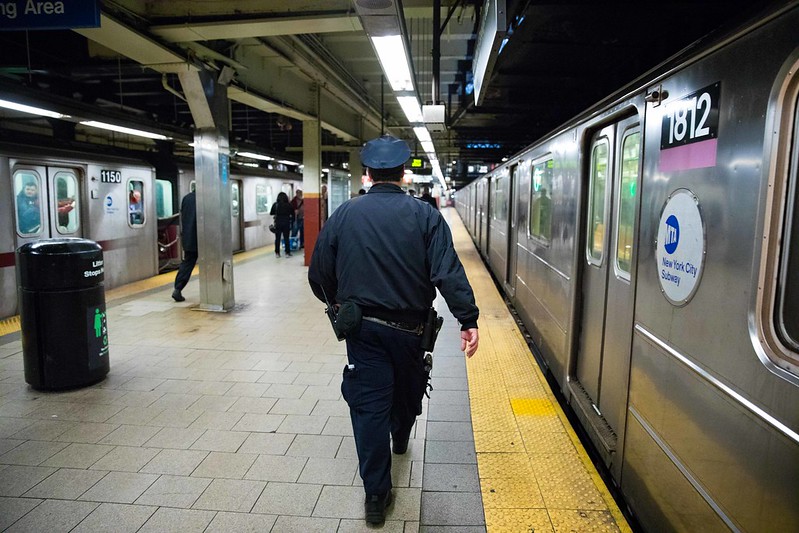
Policing the subways (photo: Benjamin Kanter/Mayoral Photo Office)
If you’ve ridden the subway recently, you could be forgiven for feeling watched. The MTA’s fare evasion crackdown is ubiquitous; subway cars are plastered with phrases like “We’d rather your $2.75 fare than your $100 fine.” Governor Cuomo’s surge of 500 NYPD and MTA cops has increased police presence in the transit system noticeably. In response, hundreds of people protested in January in Grand Central station, activists jumped turnstiles en masse, and New Yorkers are using social media to alert fellow riders to police presence in subway stations.
The crackdown should concern New Yorkers, because fare evasion enforcement is highly disproportionate. According to the most recent NYPD data, 92% of the 481 fare evasion arrests in the fourth quarter of 2019 were of non-white riders; 60% were black. Data like that led New York Attorney General Letitia James to announce a probe of racial disparities in fare evasion stops. For all this, the MTA is projected to lose money, spending $249M on new officers to recover $200M in fares, though the cops are also said to be for other purposes, like combatting robbery and assault, including on transit workers.
While the fare evasion crackdown is now familiar to straphangers, what might surprise some New Yorkers is that it isn’t just jumping the turnstile or committing more serious crimes that can get you arrested on the subway. Under New York state law, violating the MTA rules of conduct is punishable by up to 10 days imprisonment. As the New York Times has reported, this means that putting your feet up on a seat could land you in jail.
Other offenses include carrying open liquids, walking between train cars, playing music on a stereo, or carrying an animal outside of a container. Getting arrested for taking up an extra seat is probably not something most subway riders worry about, but the infrequent use of these laws does not lessen their serious consequences. For immigrants, a police encounter on the subway could be a first step toward deportation.
Fortunately, there are other ways to protect the transit system’s revenue stream and promote orderly conduct without jeopardizing the personal liberty of riders. In Washington, D.C., the city council voted to decriminalize fare evasion, overriding the mayor’s veto. That does not mean that jumping the fare gate in the capital no longer carries any consequences. Rather, fare evaders are subject to a civil fine of up to $50. What got less attention is that D.C.’s reform also decriminalized smoking, eating, littering, playing music, carrying animals, and more on the Metro. Those offenses too are punishable by a $50 fine. Another model New York could adopt is that of Portland, Oregon, where fare evaders are now granted 90 days to resolve their cases out of court.
Law enforcement in New York City has recognized that fare evasion prosecutions do not advance public safety. In 2017, Manhattan District Attorney Cy Vance announced that he would not prosecute subway fare evasion, unless there is a “demonstrated public safety reason to do so.” That is a good step, which recognizes that public safety resources are best prioritized on other matters. However, it leaves the door open to arbitrary enforcement, still requires offenders to participate in a diversion program, and widens enforcement disparities with the outer boroughs. It also calls into question the rationale for continued fare evasion arrests at all.
Legislators in Albany should follow the lead of these other jurisdictions, and repeal criminal penalties for both fare evasion and violating the MTA rules of conduct. This would not be an invitation to bad behavior, but it would make the punishment for these offenses far more proportionate. New York City has already had great success with this approach in other areas. Under the city’s Criminal Justice Reform Act of 2016, offenses like public urination, carrying open containers of alcohol, violating park rules, littering, and making excessive noise now carry civil, rather than criminal, penalties in most cases. That change resulted in tens of thousands of fewer criminal summonses being issued, and over 644,000 outstanding arrest warrants being dismissed.
If we want to meaningfully reduce mass incarceration, and make our society less punitive, we must not think of the criminal law and incarceration as the only tools to enforce rules. Decriminalizing public order offenses on the transit system would be an important step in that direction. Being poor should not be a crime, either. Fixing the subway cannot just be about improving arrival times, it must also include doing justice for all New Yorkers who rely on it.
***
Sam Rubinstein is a law student at the University of Michigan. On Twitter @Sam_Rubinstein.
***
Have an op-ed idea or submission for Gotham Gazette? Email This email address is being protected from spambots. You need JavaScript enabled to view it.
To Have Truly People-Powered Campaigns, We Need Democracy Vouchers
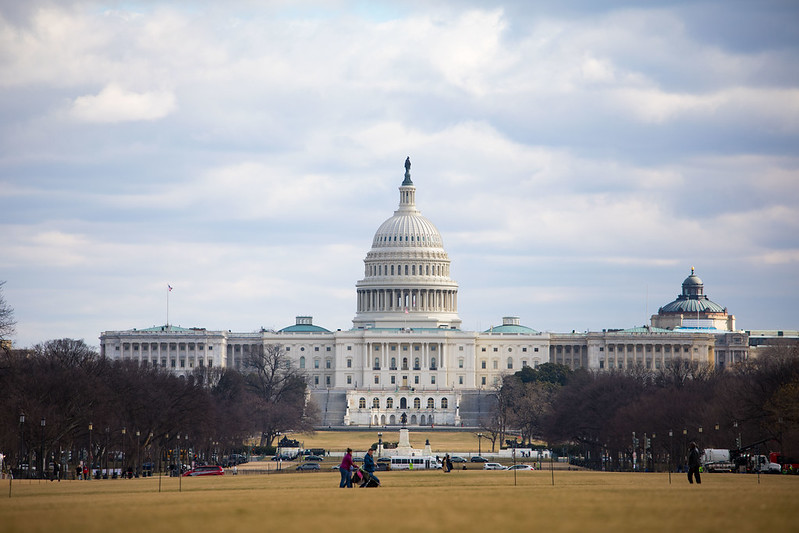
(photo: Benjamin Kanter/Mayoral Photo Office)
We’re just a few months into 2020, and it has been the focus for much of the country for months, if not years, and for good reason -- it is the most important election our democracy has faced in decades. While voter turnout is projected to be record-breaking this year, one of the greatest inequalities of our democracy still needs serious legislative reform: campaign finance.
In 2016, 15% of Americans reported making a political donation, but only 0.52% of the population controlled 67.8% of the total political donations by donating at least $200. Two years later, in 2018, the numbers were worse: 0.47% of the population contributed at least $200 to a campaign, but totaled 71% of all political donations.
Up and down the ballot, more and more candidates are making voluntary pledges to reject corporate PAC money and donations from special interest groups. Several Democratic presidential primary candidates are breaking records with their number of small-dollar donors. But these are voluntary pledges and candidates down the ballot will never be able to match the energy surrounding a presidential campaign.
Although we come from different backgrounds, we have both worked to serve our communities and have run for office against machine-backed candidates. As we can both attest, raising enough money to take on the establishment is hard and we have seen firsthand the impact of corporate money in campaigns -- and the power in the movement to remove special interest money from politics altogether.
It will take legislative change to elevate the value of small-dollar donors and fully get special interest money out of politics.
The most exciting idea, a proposal with potentially transformative effects, is Democracy Vouchers at the federal level. Democracy Vouchers are a simple concept - jurisdictions grant voters vouchers of a select dollar amount that they can donate to the candidates of their choice, as long as the candidates vow to meet certain contribution limits.
For example, every voter in America could get $50 under legislation proposed by Rep. Ro Khanna. They could only use that $50 on federal elections. People know that money matters in campaigns, and because of that, they feel (more) shut out.
Democracy Vouchers have proven to be effective — Seattle voted to implement Democracy Vouchers in 2015 and then piloted its program in 2017. The initial impact of the voucher program included doubling the percentage of giving coming from people under the age of 25 and an increase in people of color making donations. The time for Democracy Vouchers to be more widely implemented has come.
Their ability to empower people to become further engaged in the political process is tremendously important, especially in low-income areas. For too long, candidates, especially challengers, running in low-income areas have had to fundraise outside their communities to run viable campaigns — necessarily giving outsiders the power to decide what matters most and protecting incumbents. Democracy Vouchers would serve as an equalizer for all donors and create greater opportunity for low-income communities to donate to the candidates they believe in.
If we are going to continue the progress we made in 2018 to create the most diverse Congress in history, we must find ways to level the playing field so that more candidates, including women and people of color, are empowered to run. If we are truly going to rid special interests from politics, we must institute public campaign financing through Democracy Vouchers at the federal level and hold leaders accountable for letting corporations -- not people -- dictate their leadership.
***
Adem Bunkedekko is a candidate for Congress in New York’s 9th District, covering parts of Brooklyn. Zephyr Teachout is a law professor. On Twitter @ZephyrTeachout & @adembunkeddeko.
***
Have an op-ed idea or submission for Gotham Gazette? Email This email address is being protected from spambots. You need JavaScript enabled to view it.